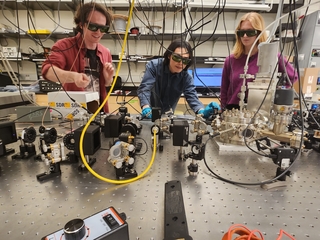Wright Lab faculty awarded grants for research on quantum information science-enabled discoveries in high energy physics

(L-R) Associate research scientist Mike Jewell, postdoctoral fellow Max Silva-Feaver, and graduate student Sukhman Singh work on wiring for ALPHA.
Yale Wright Laboratory (Wright Lab) faculty members won two out of twenty-five grants recently awarded by the U.S. Department of Energy (DOE) to projects in high energy physics that will use the emerging technologies of quantum information science to answer fundamental questions about the Universe. The projects were selected by competitive peer review under the DOE Funding Opportunity Announcement for Quantum Information Science Enabled Discovery 2.0 (QuantISED 2.0).
“Quantum information science is opening up new ways for us to understand and explore the Universe,” said Regina Rameika, DOE Associate Director of Science for High Energy Physics in a DOE Office of Science press release. “With these projects, we are supporting scientists in developing quantum technologies that will empower the next generation of theory and experiment in high energy physics.”
The two Wright Lab projects are described further, below:

ALPHA during a recent cooldown. Image courtesy of Mike Jewell.
Reina Maruyama, professor in physics, is the lead principal investigator (PI) of the 5-year, multi-institutional program called “Toward High-Mass Axion Searches with Plasma Haloscopes”. She is joined in the proposal by faculty from four other institutions, including former Wright Lab postdoctoral associate Danielle Speller, now on the faculty of Johns Hopkins University.
Additional co-PIs from Yale working on this project are Charles Brown, assistant professor of physics; Karsten Heeger, Eugene Higgins Professor of Physics and director of Wright Lab; and Steve Lamoreaux, Eugene Higgins Professor of Physics.
The aim of this program is to develop quantum sensing technologies and novel techniques to extend the search beyond present capabilities for a very low-mass particle called the axion that is a candidate for dark matter. The axion’s low mass and wave-like properties require novel approaches in quantum sensing. The program team has an established record of success in quantum sensor development and axion dark matter searches, including three experiments hosted at Wright Lab: ALPHA, HAYSTAC, and RAY (for more information on these, please see the Axion Dark Matter at Yale website.) In particular, HAYSTAC demonstrated for the first time the use of squeezed-state quantum sensors for axion searches.
Maruyama said, “I am very excited to work with these talented people to extend the experimental reach of axion mass range.”
Searching for sterile neutrinos with quantum optomechanics

Former postdoctoral associate Tom Penny and graduate students Yu-Han Tseng and Cecily Lowe demonstrate the Moore Lab’s QuIPS experiment.
David Moore, associate professor of physics, is the PI of “Searching for sterile neutrinos using quantum optomechanical sensors”.
The Moore group will use the grant to develop an experiment to search for sterile neutrinos or other “invisible” particles that may be emitted in a tiny fraction of nuclear decays, using novel techniques based on optically trapped nanoparticles in vacuum. This experiment would apply techniques from the rapidly developing field of quantum optomechanics with levitated systems to challenging sensing problems in particle physics. Quantum limited measurements are central to the proposed work, with substantial possibility to enable novel particle physics applications as quantum measurement limits are reached (and ultimately surpassed, using techniques such as squeezing or backaction evasion).
The Moore group experiment will upgrade and optimize an existing state-of-the-art experimental set-up at Wright Lab, reaching sensitivities beyond the previous best laboratory searches in the proposed mass range. This experiment will directly inform the design of a future, scaled-up experiment that will have the ability to search for sterile neutrinos or other hidden sector particles that may be related to dark matter with sensitivity well beyond existing laboratory experiments.
Moore said, “We’re excited to be part of QuantISED 2.0, which will allow us to extend our previous work detecting forces imparted by nuclear decays to smaller particles operating at the standard quantum limit, where we will have the sensitivity needed to see a single neutrino leaving our nanospheres.”
Heeger said, “The awarding of these two grants to our faculty demonstrates that Yale’s Wright Lab is at the forefront of the quest to explain the invisible Universe by developing novel quantum technologies.”